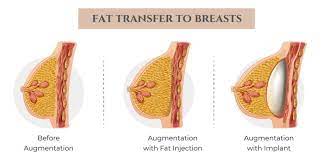A common question that is asked is “Can breast augmentation be done with body fat?” This article will address the pros and cons of this procedure, as well as discuss how it is done. Liposuction is used to harvest fat from the body, which is then used as a source of breast volume. This fat is processed in the operating theater to remove any impurities and to ensure the fat is pure enough for injection. It is then injected into the breasts to create fullness and volume.
Table of Contents
Liposuction
Liposuction is a cosmetic procedure that can be used to add volume to the breasts. The procedure requires a general anesthesia and typically takes one to one and a half hours. The surgeon will harvest fat from one or more donor areas. The fat is then transferred to a sterile syringe and injected into the breasts through two or three very small incisions. These incisions are typically less than one centimeter in length and are closed with fine sutures.
Liposuction for breast augmentation with fat has risks, and the procedure is not appropriate for everyone. Patients may experience swelling and bruising. Pain is often minimal and can be controlled with prescribed medications. The breasts may initially appear larger than expected, but this will subside as the fat cells are absorbed. In most cases, patients can return to low-impact activities within seven to ten days. However, they should avoid heavy lifting for a couple of weeks to allow for recovery.
Fat transfer to breasts
Historically, fat transfer in cost to the breasts has been used for reconstructive purposes, rather than cosmetic purposes. However, fat transfer to the breasts was not a popular procedure then, because fat extraction techniques and technology were not developed enough to produce sufficiently pure grafts.
The process of fat transfer is not invasive. Most patients will resume their regular activities within a week or two. The final result will be visible within six to 12 months. However, there are certain side effects associated with this procedure.
Retention of grafted fat
Surgical results of autologous fat transfer (AFG) for breast augmentation are highly variable. The success of AFG is determined largely by the surgeon’s skill and technique, but recipient site preparation is also an important consideration. Retention rates range from 25 percent to 80 percent. Consequently, repeated procedures may be necessary. However, cell-enrichment techniques have shown promise in improving the retention rate of grafted fat.
There are several factors that may improve the survival of fat grafts, including the use of stem cells, platelet concentrates, and fat preparations. But controlled clinical trials are still needed to verify their safety and efficacy. For example, a recent meta-analysis examined the retention rate of autologous fat grafts in Mumbai and identified factors that affect the survival rate. The researchers evaluated data from the EMBASE, PubMed, and Cochrane Library databases, which included 27 studies.
Recovery time
The recovery time for breast augmentation with body fat can vary widely. Most patients can expect to experience bruising and swelling for a few days. There will also likely be some pain, but the aching sensation should subside quickly. After about two weeks, patients can resume most normal activities. Some patients may need to take a week off work. Some patients can return to work within four weeks, while others may require up to six months.
The recovery time for breast augmentation with body fat is longer than for implant-based procedures. This is due in part to the fact that the fat cells used for the procedure will eventually be reabsorbed. However, patients who opt for this method will have less risk of infection. Also, breast augmentation with body fat will provide a more natural appearance.
Cost
The cost of breast augmentation in India with body fat is higher than the cost of traditional breast implant surgery. A fat transfer surgery costs around $5,000 to $10,000 more than a traditional breast implant surgery, but the results are much more natural looking and there is no risk of rejection. The cost of a fat transfer procedure will depend on several factors, such as the cup size, the location of the surgery, and any additional medical fees. You can request an accurate quote from your plastic surgeon by contacting him or her directly.
Conclusion
The benefits of breast augmentation with body fat include increased size and symmetry. Unlike implants, the procedure does not require physical adjustment. While you will have bruising, you will not have restrictions on weight lifting or submerging your body in water. However, it is important to keep your expectations in perspective. A fat transfer will only increase your breast size to a B cup. You should also be in good health and realistic about what you want to achieve from the procedure.

